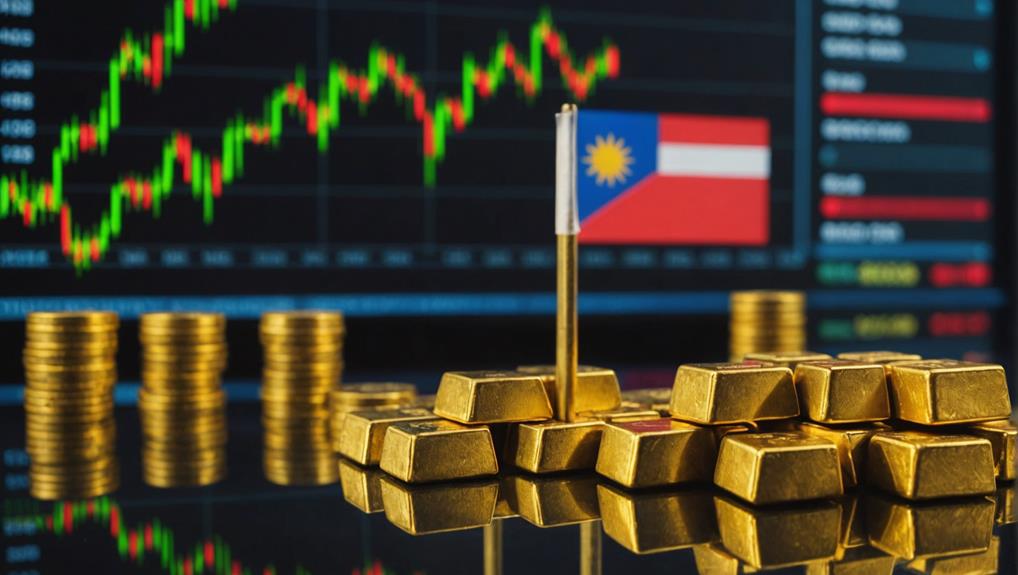Investing in gold is an enticing option for beginners in the Philippines, serving as a hedge against inflation and economic uncertainties.
To make sound investment decisions, it is crucial to understand the available options, ranging from physical gold to financial instruments.
Evaluating the reliability of sources, compliance with local regulations, and potential tax implications is essential.
Given the unique trends and opportunities in the Philippine gold market, grasping these nuances can significantly impact your investment journey.
How can one navigate these complexities effectively to build a stable and profitable portfolio?
Key Insights
- Start with Physical Gold: Purchase gold coins, bars, or jewelry from reputable dealers or the Bangko Sentral ng Pilipinas for secure transactions.
- Explore Gold ETFs and Funds: Diversify with Gold ETFs or mutual funds like the Philequity Gold Fund to gain exposure to the gold market.
- Understand Taxation: Be aware of the 6% Capital Gains Tax and 12% VAT on gold sales in the Philippines.
- Consider Storage Solutions: Use safe deposit boxes or home safes to securely store physical gold and avoid theft.
- Stay Informed on Market Trends: Monitor global economic conditions, inflation rates, and geopolitical events that impact gold prices.
Overview of Gold Investment

Investing in gold in the Philippines offers diversification and serves as a safeguard against economic uncertainties. Gold price movements in the country are influenced by global economic conditions, inflation rates, and geopolitical tensions.
Key economic indicators impacting gold investments in the Philippines include local inflation rates and the peso's performance against major currencies. Gold stands out as a valuable asset due to its tangibility and high liquidity, especially in times of financial turmoil.
In the Philippines, banks play a crucial role in gold trading by providing a range of investment products to cater to investors' needs. Tailoring gold investment strategies to suit the Philippine market involves considering both global and local economic factors to maximize returns and manage risks effectively.
Types of Gold Investments
When contemplating gold investments in the Philippines, there are various options available that cater to different investor preferences and goals. Physical gold options include purchasing gold coins, bars, or jewelry, while gold financial instruments encompass ETFs, mining stocks, and trading futures and CFDs.
Each type of investment offers unique benefits and risks, making it vital for investors to understand their individual characteristics and market dynamics.
Physical Gold Options
In the Philippines, investors have a range of physical gold investment options to choose from, including gold coins, bars, and jewelry. Reputable sources like jewelers, banks, and authorized dealers offer these options.
Gold jewelry enthusiasts can explore stores in the Philippines to find pieces in 18-karat and 24-karat gold. For those interested in gold bars, various weights such as 1 gram, 5 grams, and 10 grams are available from gold bullion dealers in the country.
Numismatists can also find gold coins like the Philippine Gold Coin and international selections through dealers in the Philippines. Pawnshops in the Philippines provide liquidity options for those looking to sell their gold holdings.
Moreover, the Bangko Sentral ng Pilipinas (BSP) ensures secure transactions through its Gold Buying Program.
Gold Financial Instruments
Gold financial instruments in the Philippines provide a diverse range of investment opportunities, including Gold ETFs, mining stocks, futures, and CFDs. Investment firms in the Philippines offer Gold ETFs tailored to the local market, enhancing liquidity and portfolio diversification.
Investors can also tap into the potential growth of the gold industry through investing in companies like Medusa Mining, Apex Mining, and Philex. Additionally, with gold futures trading and CFDs, investors can participate in gold price speculation without owning physical gold, offering flexibility in trading strategies.
The presence of gold refining companies in the Philippines further ensures the quality and availability of gold products, supporting the overall gold investment ecosystem.
Pros and Cons of Gold Investment

Investing in gold in the Philippines offers a range of advantages and disadvantages that investors need to carefully weigh. On the positive side, gold serves as a reliable hedge against currency fluctuations and provides a shield against inflation, with its value often increasing during times of economic uncertainty. Its physical presence gives it intrinsic worth, making it a secure asset during turbulent times.
However, investing in gold in the Philippines comes with its own set of risks, including the impact of inflation on gold investments and the influence of environmental regulations on gold mining practices. Moreover, storage expenses and the absence of income generation, unlike dividends or interest, are significant drawbacks to consider.
Striking a balance between these factors is essential for making well-informed decisions when it comes to gold investments.
Gold Market Trends in the Philippines
The gold market trends in the Philippines are a product of diverse factors, including local demand, global market dynamics, and regulatory oversight from the Bangko Sentral ng Pilipinas (BSP). Gold prices in the Philippines are predominantly influenced by international market trends, economic conditions, and geopolitical events, shaping the investment landscape.
Cultural preferences drive local demand, with gold being sought after for both jewelry making and investment purposes. The BSP plays a pivotal role in overseeing the gold market, ensuring ethical trading practices are upheld by all stakeholders.
Additionally, gold mining companies significantly contribute to the national economy by creating job opportunities and bolstering the country's gold reserves. Investors keen on navigating the Philippine gold market effectively must grasp these underlying trends to make informed decisions.
Buying Physical Gold

To successfully invest in physical gold in the Philippines, understanding the market trends is crucial. Reliable sources for purchasing gold include banks, jewelers, and authorized dealers. The Bangko Sentral ng Pilipinas (BSP) stands out as a reputable institution for acquiring gold. Opt for high-purity gold, such as 24-karat, and always request an assay certificate to verify authenticity.
It's essential to be aware of the taxes associated with gold investments in the Philippines, as they can impact your overall returns. When it comes to storing your gold securely, options like safe deposit boxes or home safes are recommended to mitigate the risk of theft.
Furthermore, the enduring cultural significance of gold in Philippine society emphasizes its lasting value and enduring appeal.
Investing in Gold Jewelry
Gold jewelry is a popular choice for investors in the Philippines due to its dual appeal as a decorative item and an investment asset. To maximize returns on gold jewelry investments, it is essential to consider key factors:
- Karat Purity: Opt for higher karat gold, like 24K, for its higher purity level, which can lead to more significant appreciation over time.
- Design Complexity: Intricate designs, requiring more labor and skill, can enhance the piece's value.
- Craftsmanship Excellence: Choose pieces crafted with high-quality workmanship to ensure durability and sustained market value.
- Personal Investment Goals: Align your investment choices with your financial objectives, balancing aesthetics with financial growth.
In the Philippines, reputable jewelry stores provide a wide range of options to cater to various investment preferences while guaranteeing authenticity and value retention.
Gold ETFs and Mutual Funds

Gold ETFs and mutual funds offer significant benefits in terms of liquidity and flexibility, allowing investors to easily purchase and sell shares on the stock market.
The expenses associated with these investment vehicles are generally lower compared to owning physical gold, and they often include management fees for professional oversight. This makes them an appealing option for investors seeking a diversified and cost-effective approach to gold investment, regulated by the Securities and Exchange Commission (SEC) for added security and transparency.
Liquidity and Flexibility Benefits
Gold ETFs and mutual funds offer investors in the Philippines a convenient way to access the gold market. With the ability to trade seamlessly during market hours, these investment vehicles provide unparalleled liquidity and flexibility.
Unlike physical gold, investing in gold ETFs and mutual funds eliminates the need for storage and insurance, leading to lower costs for investors. Additionally, gold mutual funds, such as the Philequity Gold Fund, offer variety by investing in a range of gold mining companies, providing exposure to different segments of the gold industry.
Costs and Management Fees
Understanding the costs and management fees associated with gold ETFs and mutual funds is crucial for optimizing investment performance.
Gold ETFs typically have lower management fees, ranging from 0.25% to 0.75% annually. In contrast, mutual funds investing in gold may incur higher fees, typically between 1% and 2% annually.
These expenses can significantly impact overall returns, so investors must carefully consider them when choosing between gold ETFs and mutual funds.
Taxation and Regulations
Navigating the gold investment landscape in the Philippines involves understanding the taxation and regulatory framework set by the Bangko Sentral ng Pilipinas (BSP). To ensure transparency and compliance with laws, investors need to consider the following tax implications:
- Capital Gains Tax: A 6% tax is levied on the net capital gains derived from the sale of gold assets.
- Value-Added Tax (VAT): A 12% VAT is applicable to the sale of gold bars, coins, and jewelry.
- Regulatory Compliance: Strict adherence to BSP regulations is mandatory for all gold transactions to maintain market integrity and protect investors.
Being mindful of these tax considerations is essential for making well-informed decisions when investing in gold in the Philippines.
Conclusion
Investing in gold in the Philippines requires a deep understanding of the available options, such as physical gold and financial instruments like ETFs. Prospective investors should conduct thorough research from reliable sources, stay informed about taxation and regulations, and carefully weigh the advantages and risks involved.
By acquiring a strong knowledge base and seeking guidance from professionals, beginners can make well-informed decisions in this complex market, potentially leading to financial growth and stability through strategic gold investments.
For more information and resources on gold investments, contact:
The Gold Information Network
11900 Biscayne Blvd, Ste 127B, Miami, FL 33181
(305) 449-9094
https://goldinfo.net







